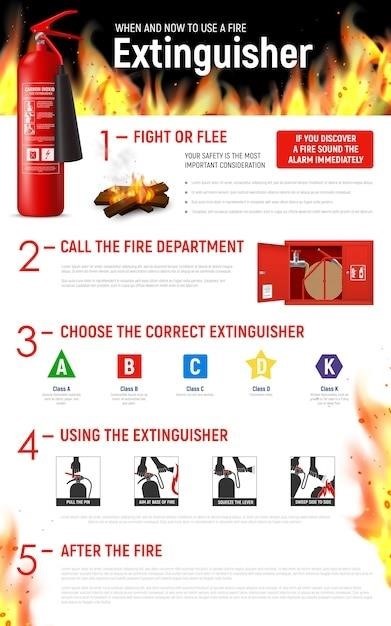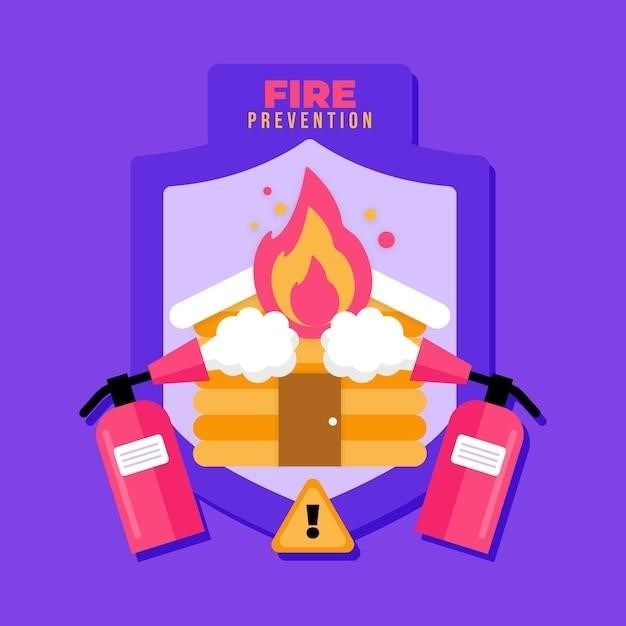NFPA 1041⁚ Standard for Fire and Emergency Services Instructor Professional Qualifications

NFPA 1041, the Standard for Fire and Emergency Services Instructor Professional Qualifications, outlines minimum job performance requirements for fire service instructors. The 2019 edition offers updated JPRs and newly identified roles, crucial for instructors. Access the PDF online to learn more about certification levels (I, II, III) and the exam process.
Overview of NFPA 1041
NFPA 1041, the Standard for Fire and Emergency Services Instructor Professional Qualifications, is a crucial document for anyone involved in fire service training. Developed by the National Fire Protection Association (NFPA), this standard sets the minimum job performance requirements (JPRs) for instructors at various levels. The document details the knowledge, skills, and abilities needed to effectively deliver training programs that meet the needs of fire service personnel. It’s designed to ensure consistent quality and competency across the industry, ultimately improving firefighter safety and effectiveness. The standard is regularly updated to reflect evolving best practices and technological advancements within the field. This ensures that instructors remain current with the latest techniques and methodologies in fire service training.
NFPA 1041 plays a vital role in maintaining high standards within the fire service, promoting a culture of continuous improvement, and enhancing the overall effectiveness of fire departments worldwide. The readily available PDF version makes it easy for instructors and training organizations to access and utilize this essential resource, ensuring compliance and best practices are consistently implemented.
2019 Edition Updates and Significance
The 2019 edition of NFPA 1041 introduced significant updates impacting the Oregon fire service and beyond. A key change involved revised Job Performance Requirements (JPRs), reflecting the evolving roles and responsibilities of fire service instructors. The updated JPRs ensure instructors possess the necessary skills and knowledge for contemporary fire service training. Two entirely new instructor roles were also identified in this edition, highlighting the expansion and diversification of training needs within the profession. The 2019 edition’s emphasis on current standards underscores the NFPA’s commitment to continuous improvement in fire service training. Adopting the 2019 edition ensures Oregon’s fire service aligns with the most up-to-date best practices and enhances the overall quality of training delivered to firefighters. This alignment is vital for maintaining a high level of preparedness and competence amongst fire service personnel, ultimately contributing to enhanced public safety. The updated document serves as a valuable tool for instructors, training organizations, and fire departments seeking to maintain compliance and deliver effective training programs.
Instructor Certification Levels (I, II, III)
NFPA 1041 establishes a tiered certification system for fire service instructors, categorized into three distinct levels⁚ Instructor I, Instructor II, and Instructor III. Each level represents a progressive increase in knowledge, skills, and responsibilities. Instructor I serves as the entry-level certification, focusing on foundational teaching methodologies and essential fire service knowledge. This level typically prepares individuals to deliver basic instruction within their respective fire departments or training programs. Instructor II builds upon the foundation established in Level I, requiring more advanced instructional skills and a broader understanding of fire service operations. Instructors at this level often take on greater responsibilities in curriculum development and program management. Finally, Instructor III represents the highest level of certification, demanding mastery of advanced instructional techniques, curriculum design, and program evaluation. Individuals holding this certification typically possess extensive experience and serve as lead instructors or training program managers, responsible for overseeing multiple instructors and training programs. The progression through these levels reflects a commitment to continuous professional development and advancement within the fire service training profession.
Job Performance Requirements (JPRs)
NFPA 1041’s core lies in its detailed Job Performance Requirements (JPRs), outlining the specific skills and knowledge necessary for effective fire service instruction at each certification level. These JPRs aren’t merely suggestions; they’re the benchmarks against which an instructor’s competency is measured. The document meticulously details the tasks instructors must be able to perform proficiently, ensuring consistent quality and safety in fire service training. These requirements encompass a broad spectrum of instructional skills, from lesson planning and delivery to assessment and feedback. Furthermore, the JPRs emphasize the importance of understanding adult learning principles, adapting instructional methods to diverse learning styles, and creating a safe and inclusive learning environment. The 2019 edition of NFPA 1041 includes updated JPRs reflecting the evolving needs of the fire service, ensuring that instructors possess the most current knowledge and skills. Compliance with these JPRs is crucial for maintaining certification and ensuring the delivery of high-quality fire service training programs.

NFPA 1041 and Oregon Fire Service
The Oregon fire service actively engages with NFPA 1041, aligning its training standards with the nationally recognized best practices outlined in this crucial document. The adoption of the 2019 edition of NFPA 1041 into Oregon Administrative Rules (OAR) demonstrates a commitment to maintaining current standards. This ensures Oregon’s fire service instructors meet the highest professional qualifications; The updated JPRs and the addition of new roles within the 2019 edition are particularly significant for Oregon’s fire service personnel. This alignment helps ensure consistency in training quality across the state, improving firefighter safety and effectiveness. The Oregon Department of Public Safety Standards and Training (DPSST) plays a key role in overseeing the implementation and adherence to NFPA 1041 within the state’s fire service. Their involvement guarantees that Oregon’s firefighters receive top-tier training, prepared for the challenges they face. This commitment to national standards benefits both the firefighters and the communities they serve, fostering a culture of excellence in fire service instruction and training.
Access to the NFPA 1041 PDF
Obtaining the official NFPA 1041 PDF requires navigating the official NFPA website. While some excerpts and summaries might be freely available online, accessing the complete, legally binding document often necessitates a purchase or subscription. The NFPA website provides clear instructions on how to obtain the document, whether through direct purchase, membership access, or other authorized channels. Purchasing the PDF ensures you have the most up-to-date and legally compliant version of the standard. This is crucial for instructors seeking certification or those responsible for ensuring training programs meet NFPA 1041 requirements. Beware of unofficial or pirated copies; these may contain outdated information or inaccuracies. Using an official copy is essential for maintaining compliance and ensuring the quality of fire service instruction. Remember to check the NFPA website regularly for updates and errata to maintain access to the most current version of NFPA 1041. This ensures that you’re always working with the most accurate and relevant information.
Examination and Certification Process
The NFPA 1041 certification process typically involves a multifaceted approach combining practical skills assessments and knowledge-based examinations. Candidates are evaluated on their understanding of instructional methodologies, curriculum development, and risk management within fire service training. The specific format and content of the examination might vary depending on the certifying agency and the instructor level (I, II, or III) being pursued. Many jurisdictions utilize a combination of written tests, practical demonstrations, and portfolio reviews to ensure comprehensive evaluation. These assessments are designed to verify the candidate’s competency in delivering effective and safe fire service instruction. Successful completion of all required components leads to certification, demonstrating adherence to NFPA 1041 standards. Details regarding application procedures, fees, and scheduling should be obtained directly from the relevant certifying authority; The process is designed to ensure a high standard of professionalism and competency among fire service instructors.
Training Course Alignment with NFPA 1041
Effective fire service training programs must align with the requirements outlined in NFPA 1041 to ensure instructors possess the necessary skills and knowledge. Courses designed to prepare individuals for NFPA 1041 certification should comprehensively cover all relevant job performance requirements (JPRs) for the targeted instructor level. This includes modules on instructional design, adult learning principles, curriculum development, assessment techniques, and risk management strategies specific to fire service training environments. Hands-on practical exercises and simulations are crucial components, allowing trainees to apply theoretical knowledge to realistic scenarios. Furthermore, training should emphasize the importance of cultural diversity and inclusivity in instruction, mirroring NFPA 1041’s emphasis on equitable and accessible learning experiences. Successful completion of an NFPA 1041-aligned course demonstrates a trainee’s readiness to meet the rigorous demands of fire service instruction while upholding the highest standards of safety and professionalism. Regular updates to training materials are essential to reflect changes and revisions in NFPA 1041.
The Role of the Fire Service Instructor
The fire service instructor plays a pivotal role in ensuring the safety and effectiveness of fire departments. They are responsible for delivering high-quality training programs that equip firefighters with the knowledge, skills, and abilities necessary to perform their duties safely and efficiently. This involves developing and delivering engaging and effective training curricula that align with NFPA standards and best practices. Instructors must be adept at utilizing various teaching methodologies, catering to diverse learning styles. Beyond technical skills, fire service instructors cultivate a strong safety culture within their departments, emphasizing risk management and accident prevention. They act as mentors and role models, fostering professional development and teamwork amongst firefighters. Effective instructors stay current with advancements in fire science, technology, and emergency response techniques. Their commitment to continuous professional development ensures that they remain at the forefront of their field, capable of providing the most up-to-date and relevant training. Ultimately, the fire service instructor’s dedication directly impacts community safety and well-being.
NFPA 1041 and Cultural Diversity
NFPA 1041 emphasizes the crucial role of cultural diversity and inclusion in fire service instruction. Effective training programs must acknowledge and address the diverse backgrounds, experiences, and perspectives of all learners. Instructors should create inclusive learning environments where individuals feel respected, valued, and empowered to participate fully. This involves utilizing culturally sensitive instructional materials, adapting teaching methods to accommodate different learning styles, and promoting open communication and dialogue. Recognizing and mitigating potential biases in training materials and assessments is paramount. Instructors should actively strive to understand and overcome their own biases, ensuring fair and equitable treatment of all learners. By fostering a diverse and inclusive learning environment, fire service training programs can better prepare firefighters to serve diverse communities effectively and compassionately. The goal is to create a safe and welcoming space for all, where everyone feels comfortable contributing their unique skills and perspectives, ultimately strengthening the fire service as a whole.
Resources and Further Information
For comprehensive information on NFPA 1041, including the full PDF of the standard, visit the official NFPA website. This resource provides access to the latest edition, updates, and interpretations. Many online bookstores also offer the NFPA 1041 standard for purchase as a PDF or printed copy. State fire marshal websites often provide additional resources, guidance, and training materials specific to their jurisdictions. Professional organizations such as the International Association of Fire Chiefs (IAFC) and the National Volunteer Fire Council (NVFC) offer training programs and resources aligned with NFPA 1041. These organizations frequently host conferences and workshops that provide opportunities for networking and professional development. Searching for “NFPA 1041 training” will reveal numerous certified training courses available both online and in-person. Remember to verify the legitimacy and accreditation of any training program before enrolling. Staying informed about updates and changes to NFPA 1041 is crucial for maintaining current knowledge and best practices in fire service instruction. Regularly consult the NFPA website and relevant professional organizations for the most up-to-date information.